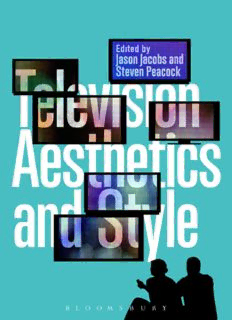
Television Aesthetics and Style PDF
Preview Television Aesthetics and Style
Television Aesthetics and Style Television Aesthetics and Style EDITED BY JASON JACOBS AND STEVEN PEACOCK Bloomsbury Academic An imprint of Bloomsbury Publishing Plc 1385 Broadway 50 Bedford Square New York London NY 10018 WC1B 3DP USA UK www.bloomsbury.com First published 2013 © Jason Jacobs, Steven Peacock and Contributors 2013 All rights reserved. No part of this publication may be reproduced or transmitted in any form or by any means, electronic or mechanical, including photocopying, recording, or any information storage or retrieval system, without prior permission in writing from the publishers. No responsibility for loss caused to any individual or organization acting on or refraining from action as a result of the material in this publication can be accepted by Bloomsbury Academic or the author. Library of Congress Cataloging-in-Publication Data Television aesthetics and style / edited by Jason Jacobs and Steven Peacock. pages cm Includes bibliographical references and index. ISBN 978-1-4411-7992-0 (hardcover : alk. paper) -- ISBN 978-1-4411-5751-5 (pbk. : alk. paper) 1. Television broadcasting--Aesthetics. 2. Television--Aesthetics. I. Jacobs, Jason editor of compilation. II. Peacock, Steven, 1974- editor of compilation. PN1992.55.T3865 2013 791.4502--dc23 2013004521 ISBN: 978-1-6235-6903-7 Typeset by Fakenham Prepress Solutions, Fakenham, Norfolk NR21 8NN Contents Acknowledgements ix Contributors xi Introduction 1 Jason Jacobs and Steven Peacock PART ONE Conceptual debates 21 1 Television aesthetics: Stylistic analysis and beyond 23 Sarah Cardwell 2 The qualities of complexity: Vast versus dense seriality in contemporary television 45 Jason Mittell 3 What does it mean to call television ‘cinematic’? 57 Brett Mills 4 Rescuing television from ‘the cinematic’: The perils of dismissing television style 67 Deborah L. Jaramillo PART TWO Aesthetics and style of television comedy 77 5 Why comedy is at home on television 79 Alex Clayton vi CONTENTS 6 Situating comedy: Inhabitation and duration in classical American sitcoms 93 Sérgio Dias Branco 7 Arrested developments: Towards an aesthetic of the contemporary US sitcom 103 Timotheus Vermeulen and James Whitfield 8 Better or differently: Style and repetition in The Trip 113 James Walters 9 The presentation of detail and the organisation of time in The Royle Family 125 James Zborowski 10 The man from ISIS: Archer and the animated aesthetics of adult cartoons 135 Holly Randell-Moon and Arthur J. Randell PART THREE Critical analyzes of television drama 145 11 Don Draper and the promises of life 147 George Toles 12 Justifying Justified 175 William Rothman 13 HBO aesthetics, quality television and Boardwalk Empire 185 Janet McCabe 14 Storytelling in song: Television music, narrative and allusion in The O.C. 199 Faye Woods CONTENTS vii 15 Camera and performer: Energetic engagement with The Shield 209 Lucy Fife Donaldson 16 Flashforwards in Breaking Bad: Openness, closure and possibility 219 Elliott Logan 17 The fantastic style of Shameless 227 Beth Johnson PART FOUR Non-fiction and history 239 18 ‘Let’s just watch it for a few minutes’: This is Your Life in 1958 241 Charles Barr 19 Gaudy nights: Dance and reality television’s display of talent 251 Frances Bonner 20 Television sublime: The experimental television of Lithuanian CAC TV 269 Linus Andersson 21 Closer to the action: Post-war American television and the zoom shot 277 Nick Hall 22 Think-tape: The aesthetics of montage in the post-war television documentary 289 Ieuan Franklin viii CONTENTS 23 What FUIs can do: The promises of computing in contemporary television series 309 Cormac Deane Index 323 Acknowledgements Thank you first and foremost to the contributors Linus Andersson, Charles Barr, Frances Bonner, Sérgio Dias Branco, Sarah Cardwell, Alex Clayton, Cormac Deane, Lucy Fife Donaldson, Ieuan Franklin, Nick Hall, Deborah L. Jaramillo, Beth Johnson, Elliott Logan, Janet McCabe, Brett Mills, Jason Mittell, Holly Randell-Moon, Arthur J. Randell, William Rothman, George Toles, Timotheus Vermeulen, James Walters, James Whitfield, Faye Woods and James Zborowski. Equally heartfelt thanks to Katie Gallof at Bloomsbury for her support, guidance and enthusiasm for the project. Parts of the Introduction appeared in guest blogs by Jason Jacobs and Steven Peacock for CST Online, and in Critical Studies in Television 3:1 (2008) and 4:2 (2009). We are grateful to the editors for permission to reprint. Steven would like to thank his colleagues at the University of Hertfordshire for their enthusiastic backing. Jason is grateful for the support of the Cultural History Project funded by the Faculty of Arts at the University of Queensland. This book is dedicated to Leigh and Val.
Description: